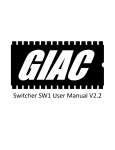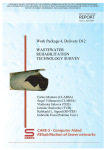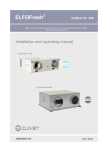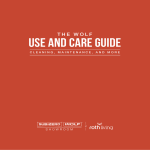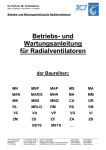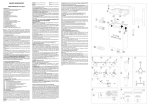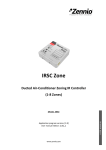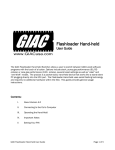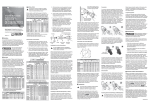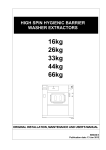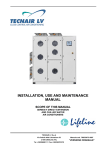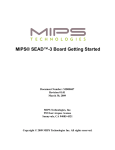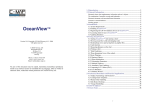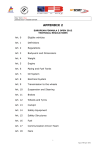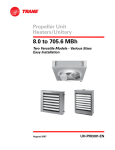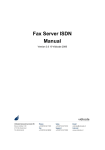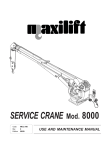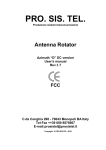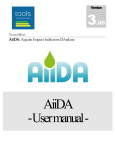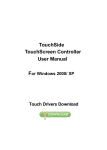Download Maintenance Instruction Centrifugal Blowers
Transcript
YOUR PARTNER FOR FANS AND BLOWERS Steel I Stainless Steel I Aluminium I Plastic Maintenance Instruction - Centrifugal Blowers Maintenance Instruction Centrifugal Blowers Type: MN MSP MAP MS MA MAR MAR/S MHR MH MM MB MBS MBQ CA GR RL MRLQ RM RU VM VC VA VP VG VI ZM ZD ZC ZA ZB BSTS MSTS … ACF Ventilatoren GmbH Registered office Elf Stücken 21 D - 49324 Melle Phone: +49(0)5422 - 9895 - 0 Fax: +49(0)5422 - 9895 - 15 www.acf-ventilatoren.de [email protected] VAT (ID) Number: DE 814776828 Tax-No.: 65/200/18329 District Court Osnabrück Com.-Reg.: HRB 200792 General Manager: Dipl.-Wirt.-Ing. Kristiaan Swaczyna Axial Fans Centrifugal Blower ATEX-Blower 400°/2h Blower Roof Fans Wall Fans Pipe Blower Special Blower YOUR PARTNER FOR FANS AND BLOWERS Steel I Stainless Steel I Aluminium I Plastic Maintenance Instruction - Centrifugal Blowers 1. PREAMBLE Thank you very much for having purchase a ACF Ventilatoren GmbH (hereinafter referred to as ACF) product. The information you can find in this user manual can not be used for any purpose other than the one for which the user manual has been drawn up. The publication and documentation which have been supplied with the fan can be reproduced neither partially nor totally without ACF’s written consent. The schematic drawings and illustrations representing the machine are only understood as a didactic reference. The content of this manual can be modified by ACF without any prior notice and without incurring any sanction. 2. INTRODUCTION The Centrifugal fans can be single aspiration or double aspiration type, in any case the air enters in the impeller with axial direction and leaves with tangent to blades plan direction. Fans are intended to move clean air volumes or air mixed with dusts or particles of variable granulometry by means of channels or pipelines according to the use conditions described by ACF catalogues and summed up by the table on page 3. Any unintended use is forbidden. The main components and eventual accessories are brought back in point 22 of this manual (Parts Lists). The fans but exceptions are paint by epoxy powder varnishes having anti-oxidant function. Fans are supplied with MEC standardised 2, 4, 6 or 8 pole motors. Guarantee: ACF guarantees its own fans for a period of 12 months starting from the delivery date. The guarantee shall be understood as limited to the sole replacement of any component or accessory which is held to be defective by ACF as a result of its false assembly or manufacture. Any other responsibility and obligation for any direct or indirect expense, damage and loss deriving from the use or from the total or partial impossibility of using the fan is excluded. The repair in guarantee and the restitution of the product are understandings as ex our factory. Therefore every transport cost or pack inherent to the same repair are to cargo of the purchaser. Varying SV and SW (Suitable for Warm Gases): In order to dissipate part of the heat which had to the warm gas presence, between the motor and the case of the fan, an aluminium fusion cooling impeller, opportunely protect by metallic grill. Such cooling impeller, in function of the type and/or model of fan in examination, it can be fastened directly on the motor shaft or on the extended impeller hub. 3. IDENTIFICATION PLATE In case of demand for assistance, always make reference to the data brought back on the nameplate. The fans that do not bring back on the nameplate “CE”, must be complete from the purchaser who will have to then certify all the system. the fans that work in a potentially explosive atmosphere in compliance with the Directive "ATEX" 94/9/CE, are identify with a nameplate bringing back the following indications: □ □ □ □ □ □ Manufacturer’s name and address Type and series identification Manufacturing year CE mark Ex symbol inside a hexagon ATEX string reporting symbol declaring explosion risk and: - Group (ex. II: equipment meant for surfaces and sites other than the mine) - Zone (ex. 2: high protection level) - Category (ex. G: protection against a potentially explosive gas) - maximum fan surface temperature class (ex. T3) ACF Ventilatoren GmbH Registered office Elf Stücken 21 D - 49324 Melle Phone: +49(0)5422 - 9895 - 0 Fax: +49(0)5422 - 9895 - 15 www.acf-ventilatoren.de [email protected] VAT (ID) Number: DE 814776828 Tax-No.: 65/200/18329 District Court Osnabrück Com.-Reg.: HRB 200792 General Manager: Dipl.-Wirt.-Ing. Kristiaan Swaczyna Axial Fans Centrifugal Blower ATEX-Blower 400°/2h Blower Roof Fans Wall Fans Pipe Blower Special Blower YOUR PARTNER FOR FANS AND BLOWERS Steel I Stainless Steel I Aluminium I Plastic Maintenance Instruction - Centrifugal Blowers 4. WORKING CONDITIONS AND CHARACTERISTICS Series MN MSP MAP MS MA MAR MAR/S MHR MH MM MB MBS MBQ CA GR RL MRLQ RM RU VM VC VA VP VG VI ZM ZD ZC ZA ZB MSTS BSTS Working conditions and characteristics t MN blowers are particularly suited for cooling D.C. motors, lamps, extruders, etc., to extract fumes and gasses and in all applications that require moving large volumes of channelled air. MSP blowers are particularly suited for cooling D.C. motors, lamps, extruders, etc., to extract fumes and gasses and in all applications that require moving large volumes of channelled air. MAP blowers are particularly suitable for machines that work plastic materials and sandblasting machines. MS blowers are particularly suited for exhaust gas suction and for automatic machine and plastic material industry and granulator. MA blower are particularly suited for blowing clean air or air containing quantities of dust up to a maximum temperature of 90°C. This series may be used in industrial systems which require a relatively small flow-rate with highpressure such as for example: liquid fuel burners, pneumatic conveyor-systems, etc. MAR blowers are particularly suited to blowing clean air of air containing small quantities of dust up to a maximum temperature of 90°C. They may be used in the glass-working industry, in the textile and chemical industry. MHR blowers are particularly suited to blowing clean air or air containing small quantities of dust up to a maximum temperature of 90°C. They may be used in industrial plant applications where a relatively small flow-rate with high pressure is required, such as: blowing nozzles, very long pipe runs, pneumatic conveyor systems, etc. MM blowers are particularly suited for blowing air and fumes, even containing small quantities of dust up to a maximum temperature of 90°C. They may be used in domestic and industrial ventilation systems. MB blowers are particularly suited to blowing air or fumes even containing small quantities of dust up to a maximum temperature of 80°C. They are widely used in domestic or industrial ventilation, heating and air conditioning systems. High capacities, medium-high pressures. They may be used for pneumatic conveyance, gasses, granulated materials. Suitable for the transport of solid materials mixed with air, sawdust and woodchips if fan is not crossed. Standard execution for air temperature up to 60°C, special execution for higher temperatures Very high capacities, low pressures. They may be used for the suction of clean or slightly dusty air and the most various uses in the industrial field and for uses civil and industrial air conditioning systems. Standard execution for air temperature up to 60°C, special execution for higher temperatures. High capacities, medium pressures. They may be used for suction and transport of air, sawdust, woodchips, granulated materials with the exclusion of fibrous materials. Standard execution for air temperature up to 60°C, special execution for higher temperatures. High capacities, medium pressures, high performances. They may be used for suction and transport of air, pneumatic transport, drying systems, sawdust, woodchips, granulated materials with the exclusion of fibrous materials. Standard execution for air temperature up to 60°C, special execution for higher temperatures. Medium and low capacities, high-pressures. They may be used for the pneumatic conveyance, gasses, granulated materials. Suitable for the transport of solid materials mixed with air, sawdust, and woodchips if the fan is not crossed. Standard execution for air temperature up to 60°C, special execution for higher temperatures. Low capacities, high-pressures. They may be used for the pneumatic conveyance, dirty air, drying systems. Particularly suitable for foundries, food and chemical industry. Standard execution for air temperature up to 60°C, special execution for higher temperatures. Medium and low capacities, high-pressures. They may be used for the pneumatic conveyance, dirty air, drying systems. Particularly suitable for foundries, food and chemical industry. Standard execution for air temperature up to 60°C, special execution for higher temperatures. Medium and low capacities, high-pressures. They may be used for the pneumatic conveyance, dirty air, drying systems. Particularly suitable for foundries, food and chemical industry. Standard execution for air temperature up to 60°C, special execution for higher temperatures. Low capacities, medium-high pressures. They may be used for the pneumatic conveyance of solid materials mixed with air, sawdust and woodchips; particularly suitable for fibrous materials that could clog a reverse type impeller of normal construction. Standard execution for air temperature up to 60°C, special execution for higher temperatures. MSTS blowers have been devised specifically for use in garment pressing sectors on an industrial scale (with centralised systems for one or more presses) and are just as suitable for supplying ovens and burners where constant air pressure determines the good functioning of the system. BSTS blowers are particularly suitable to treat clean air or fluids; if it should work in dusty environments it is better to equip it with an inlet filter. ACF Ventilatoren GmbH Registered office Elf Stücken 21 D - 49324 Melle Phone: +49(0)5422 - 9895 - 0 Fax: +49(0)5422 - 9895 - 15 www.acf-ventilatoren.de [email protected] VAT (ID) Number: DE 814776828 Tax-No.: 65/200/18329 District Court Osnabrück Com.-Reg.: HRB 200792 General Manager: Dipl.-Wirt.-Ing. Kristiaan Swaczyna Axial Fans Centrifugal Blower ATEX-Blower 400°/2h Blower Roof Fans Wall Fans Pipe Blower Special Blower YOUR PARTNER FOR FANS AND BLOWERS Steel I Stainless Steel I Aluminium I Plastic Maintenance Instruction - Centrifugal Blowers 5. WARNING Safety precautions and instructions □ All exposed people shall strictly follow the safety and accident prevention rules in force. □ The fan user shall make sure that all the instructions given by this user manual are scrupulously and unmistakably followed. □ The fan may be only installed by properly trained and qualified personnel. □ Service or repair operations may be only carried out by skilled personnel in compliance with the instructions given by this manual. □ Before carrying out any maintenance and/or regulation operation, disconnect the fan from its power supply sources. □ Any change to the fan may be only made by the personnel who have been authorised by ACF □ While connecting or disconnecting the power supply cable, make sure that the earth wire is always the first and the last wire which is respectively connected and disconnected; □ Lend attention to the tags placed on the fan. □ Never expose the fan to water jets. □ Safety protections shall never be removed. If absolutely required, it is necessary to take any measure promptly in order to point out any possible danger. Protections shall be restored as soon as the reason for their temporary removal has ceased to exist. □ It is absolutely forbidden to provide for a makeshift connection. □ Never use the fan for any unintended purpose. □ Before operating the fan, make sure there is no dangerous condition. □ Never start the fan if the inspection door has not been put back into its position and locked by means of bolts. □ Before opening the inspection door, make sure that the rotating parts are not moving and that the electric line is not live. □ If the suction and/or outlet mouths are not canalised, provide for the arrangement of a proper protection net or grille. □ It is forbidden to service, clean or repair the fan when it is working (moving). □ It is absolutely forbidden to use your hands or your tools in order to try to brake any rotating member and to accelerate their stop. □ If the machine is equipped with a pulley, stop the machine before moving the belt manually in order to change the speed rate. □ Never leave any material in the proximity of any piece which can be either rotated or operated. □ In case of a power failure, promptly disconnect the main switch of the machine. □ Always use protection gloves, masks and glasses to clean. □ The fans shall be stored in a closed place where there is no dust and where humidity will never exceed 80%; □ Never store the fan in the proximity of any machine which may produce vibrations. Otherwise, the bearings will support the same type of stress. Personnel selection and qualification □ Service or repair operations shall be carried out by skilled personnel in compliance with the instructions given by this manual. □ Spare parts may be only replaced by qualified personnel. □ The fan may be installed and operated for the first time by properly trained and qualified personnel. □ The fan may be only handled by qualified personnel in compliance with the safety rules in force by means of a fork lift or crane. Clothing □ It is very important not to underestimate the dangerousness of any rotating part. Any fluttering garment may get caught up and drag the person wearing the garment against the machine. Safety rules for use, maintenance and repair □ Before operating the machine, make sure that all eventual metal chips and tools used to clean the machine have been removed from the scroll. 6. ACCIDENT PREVENTION DEVICES The range of ACF fans is complete with accident prevention apparatuses and accessories on different rotating parts, in compliance with UNI 10615 standards, and namely: □ protection nets absolutely indispensable which shall be installed on the suction and pressing mouths if they are not canalized (to demand upon the order in how much ACF cannot know where they will be installed the own products); □ protection case of the cooling impeller; □ protection guard for pulleys, the belts and shafts of driven fans. □ In the case in which the fans are not canalized, it will have be to cure of the user to preview the opportune systems that they prevent to the access to the inside of the fan of strangers things who could damage it. □ Before starting the fan, make sure that all protections have been properly installed. ACF DISCLAIMS ALL RESPONSIBILITY FOR ANY DIRECT AND INDIRECT ACCIDENT TO THINGS OR PERSONS CAUSED BY THE ABSENCE OF SUCH ACCIDENT PREVENTION DEVICES 7. Noise The noise levels values of ACF fans are expressed in decibel scale A (dB/A) and are obtained by taking the measurements on a free field, at the maximum efficiency level, on the 4 cardinal points, 1.5 m. far from the fan. The fan is canalised in compliance with the UNI 10531 standards during the test. The values which have been measured are specified by ACF catalogues. They can be different from ACF Ventilatoren GmbH Registered office Elf Stücken 21 D - 49324 Melle Phone: +49(0)5422 - 9895 - 0 Fax: +49(0)5422 - 9895 - 15 www.acf-ventilatoren.de [email protected] VAT (ID) Number: DE 814776828 Tax-No.: 65/200/18329 District Court Osnabrück Com.-Reg.: HRB 200792 General Manager: Dipl.-Wirt.-Ing. Kristiaan Swaczyna Axial Fans Centrifugal Blower ATEX-Blower 400°/2h Blower Roof Fans Wall Fans Pipe Blower Special Blower YOUR PARTNER FOR FANS AND BLOWERS Steel I Stainless Steel I Aluminium I Plastic Maintenance Instruction - Centrifugal Blowers those which can be measured on the plants, according to environmental installation and operation conditions. To reduce the noise level, it is recommended to insulate the fan from the ground and canalisation by means of vibration-damping supports and sucking flexible joints. 8. BALANCING All the impellers of ACF fans are statically and dynamically balanced before the assembly in compliance with the ISO 1940/1 standard. The balancing degree is equal to 6,3. 9. □ □ □ PACKAGE, TRANSPORTATION AND HANDLING If the fan is not packed, close the suction and outlet mouths to prevent any dirty and/or foreign body from penetrating inside. Never use the shaft, the motor or the impeller to bring up the fan. For particularly long and bumpy distances, block the impeller in order to avoid damages to the bearings of the motor and balancing problems of the rotary parts Follow these simple rules to lift a fan correctly: A) Keep your body in a balanced position and bend your knees to lift the material. B) Hold yourself upright and keep your arms rigid. C) Take the fan with the palm of your hands by keeping your feet at a certain distance to ensure the stability of your body. D) The effort shall be mainly supported by your lower limbs during the lifting. E) Keep the fan leaning against your body during the transportation by distributing the weight on your arms without swinging. F) Never transport the fan when your hands are filthy. G) Never forget to use proper protection devices: gloves and shoes. Handling by means of a fork lift or crane The fan shall be handled by qualified personnel in compliance with the rules in force by means of a fork lift or crane. Before moving a fan, make sure that the means has got a correct capacity. When handling the fan, never exceed the carriage capacity limits. The main risks relative to the lift trucks used to move the fans are due to: a) The truck operator’s imprudence; b) The falling down of the fan when it is either transported or stacked; c) The turning over of the means when the speed is too high or the fan is too heavy. The carriage is a means manufactured to move on flat surfaces; Any flooring with holes or bumps is very dangerous. If the way should be either sloping or winding or if the road surface should be irregular, it is absolutely necessary to avoid any sharp starting or braking in order to prevent the means from turning over. The maximum height of the fan shall be such that the head of a person of average height in front of the carriage can be seen from the driver’s seat. If the fan should be so high that your view is blocked, go into reverse or let an operator go before the carriage and signal its presence. If a fan is transported by means of a fork lift, make sure that the heaviest and lightest part is respectively at the bottom of the forks and the points. Never leave the fan hanging in the air. To lift a fan by means of a rope or fork crane, use the hooking points only. Never forget to distribute the load uniformly. Handling shall occur with the utmost care. Avoid any crash which might compromise the correct operation. 10. INSTALLATION □ The first starting must be of short duration for the control of the direction of rotation parts. For direct drive fan, the direction of rotation can be controlled on the electric motor. compare the direction of rotation with the arrow (adhesive) being on the ventilator or on the plate. If it is not the same, detach the fan from the power supply and reverse the phase in the motor; Before installing the fan, make sure that the fan has not been damaged during its transportation and that the inspection door has been closed. Make sure that there is no foreign body inside and that all bolts have been firmly tightened; make sure that the rotating parts can move freely. If the fan should be either supplied or shipped before its assembly for any reason whatsoever (transportation, etc.), follow the instructions, diagrams and drawings given by this manual for a correct assembly which shall be performed by qualified personnel. For the connection to the motor terminal box, strictly follow the wiring diagrams shown by point 23 of this manual. □ □ □ ACF Ventilatoren GmbH Registered office Elf Stücken 21 D - 49324 Melle Phone: +49(0)5422 - 9895 - 0 Fax: +49(0)5422 - 9895 - 15 www.acf-ventilatoren.de [email protected] VAT (ID) Number: DE 814776828 Tax-No.: 65/200/18329 District Court Osnabrück Com.-Reg.: HRB 200792 General Manager: Dipl.-Wirt.-Ing. Kristiaan Swaczyna Axial Fans Centrifugal Blower ATEX-Blower 400°/2h Blower Roof Fans Wall Fans Pipe Blower Special Blower YOUR PARTNER FOR FANS AND BLOWERS Steel I Stainless Steel I Aluminium I Plastic Maintenance Instruction - Centrifugal Blowers NOTE The electric equipment previewed by the user should include: fuses, voltage overload and fall protections chosen to fit the effective starting time and the full load current. Detect the absorbed current on one of three line conductors L1 L2 L3. In the connection Υ Δ the reading must be done before the commutator. If this is not possible, detect the phase current on any of the six conductors and multiply the measured value by 1,73. The user should earth the fan (!!!! Check the earth connection) 11. ENVIRONMENT The use of the fan will require no special lighting source in compliance with the UNI EN 10380 standards. The available light is enough. 12. MINIMUM SPACE FOR USE AND MAINTENANCE Place the fan in such a way that a minimum space is guaranteed for service and repair operations. 13. BASES AND STRUCTURES OF SUPPORT □ The flatness and sturdiness of the surface intended to support the fan static and dynamic load. For elevated performances fans, it is advised to use reinforced concrete slabs. If the fan comes supported on a metallic structure, lend attention to the fact that this is sufficiently rigid to support the double quantity of the weight of the fan. It is recommended to place vibration-damping members (vibration-damping supports and joints which have been properly dimensioned) between the fan and the interfaces (floor and foundations). The supports shall not be completely crashed and they should support a basic rame instead of single frame elements (however, it is advisable to consult ACF for their selection). □ □ LEVELLING: It is very important to level the structure intended to support the fan in order to avoid noxious vibrations and foreign noises. 14. POWER SUPPLY AND ELECTRIC CONNECTION □ □ Make sure that the voltage and frequency specified by the fan plate and/or electric motor will correspond to the operation voltage and frequency of the plant in use. Connect the fan with a plant in accordance with the law by means of a differential switch (ground fault interrupter). The minimum cross section of electric connection cables shall be chosen on the basis of voltage, the power installed and the distance etween the source and use. All electric connection cables shall be connected in such a way that they can be neither torn nor damaged. 15. COMMISSIONING/TESTING □ □ Make sure that all bolts are firmly tightened after a one-hour operation. If necessary, repeat the tightening process. It is good practice to check the current absorbed by the motor. Its value shall be lower than the motor rating value. 16. START/OPERATION/STOP □ □ Before starting the fan, it is necessary to: □ Make sure that all the bolts and nuts are firmly tightened. Special attention shall be paid to the fastening screw of the impellerb on the motor shaft and its supports. □ Make sure that the impeller will rotate freely (use your hands to rotate it). □ Avoid starting the fan consecutively. This will involve continuous overloads which will overheat the electrical parts. Before restarting, let the motor cool down. □ It always must be previewed from 5,5 kW up, star-delta connection or inverter or other type of gradual starting; □ The fans may have very long starting times and absorption peaks as high as the maximum multiplier of the rated amperes of the electric motor; therefore, the whole electric system must be dimensioned according to the starting times and peak absorption levels. □ After some working hours, check that vibrations have not loosened the tightening of bolts and nuts or changed the tension of belts 17. MAINTENANCE/INSPECTIONS/CHECKS □ Before carrying out any service operation, make sure that the fan has been electrically disconnected that all moving parts are not working. Check the painted metal structures at least once a year in order to prevent any corrosion phenomenon. □ ACF Ventilatoren GmbH Registered office Elf Stücken 21 D - 49324 Melle Phone: +49(0)5422 - 9895 - 0 Fax: +49(0)5422 - 9895 - 15 www.acf-ventilatoren.de [email protected] VAT (ID) Number: DE 814776828 Tax-No.: 65/200/18329 District Court Osnabrück Com.-Reg.: HRB 200792 General Manager: Dipl.-Wirt.-Ing. Kristiaan Swaczyna Axial Fans Centrifugal Blower ATEX-Blower 400°/2h Blower Roof Fans Wall Fans Pipe Blower Special Blower YOUR PARTNER FOR FANS AND BLOWERS Steel I Stainless Steel I Aluminium I Plastic Maintenance Instruction - Centrifugal Blowers □ □ □ □ □ □ It is recommended to make sure at regular intervals, i.e. every four months, that all bolts are firmly tightened Special attention shall be paid to the fastening screw of the impeller on the motor shaft. it is advisable to constantly verify the impeller to ensure that it is kept clean. If material, dust, greasy substances etc. are allowed to build up on the rotor, it will become unbalanced, thereby causing damage to the driving members and/or electric motor. When cleaning the rotor, make sure you thoroughly clean every single part; residues left in confined spots may cause more unbalancing than a uniform layer of dirt. If the impeller is encrusted, clean it carefully in all its parts. Use a metal brush and an aspirator to remove all the material. If it is necessary to remove the impeller, act as follows: Loosen the bolts (or nuts) intended to fasten the nozzle to the fan side and remove it. Remove the screw and the washers intended to fasten the impeller to the motor shaft. Use an extractor to remove the impeller from the shaft. Act in the reverse order for the assembly. The electric motors assembled on the fans require no special maintenance since the bearings are lubricated for life; In a fan, the only programmed maintenance operations concern the lubrification of bearing (if these are not proof) and the verification of the corrected tention of the belts. Lubrication □ The ACF fan blocks contain bearings provided with a grease cup; ACF delivers the fans already adequately lubrificated and ready for operation. The lubrication times tfa for radial ball bearings, tfb for straight roller bearings and tfc for revolving roller bearings can be drawn from diagram (page 53) as a function of the rotational speed n of the bearing and of the diameter d of is hole. The diagram is valid for bearings of horizontal shafts and in the presence of normal loads. It can be applied to good quality lithium greases at a temperature not higher than 70°C. Because of the rapid ageing of the grease following an increase in temperature, we recommend to halve time intervals every 15°C increase in the working temperature of the bearing, but still without never exceeding the maximum admissible temperature for the grease (see the table). □ ACF recommends using grease of the type: SKF LGEP 2; □ If the block or support is protected by a guard, make sure that you replace the protective plastic plugs in the openings providing access to the grease cups. □ ACF fans are dimensioned so to guarantee a bearing life of 20.000/30.000 hours of continuous operation. However this warranty is valid only for drives calculated and installed at our factory; Type of grease (Thickening Lithium base Complex lithium Sodium base Complex sodium Calcium base Complex calcium Complex barium Complex aluminium Inorganic thickening agents (bentonite, silica gel, etc.) Polyurea Recommended operation from °C -30 -20 -30 -20 -10 -20 -20 -30 -30 -30 Temperature rangeto °C +110 +140 + 80 +140 + 60 +130 +130 +110 +130 +140 Application mode: Clean the attachment of the grease cup. The addition of grease is to be performed by making the shaft rotate slowly without exceeding the quantity to avoid overheating. The amount of grease to be introduced can be determined by this formula: P = 0,005 A B (gr) where A= external diameter of the bearing in mm and B= length of the ring in mm If high pressure grease cups are used, these should be accurately cleaned after their use. Cleaning the impeller It is absolutely necessary to control the cleanliness of the impeller. Every type of dirt may cause an unbalance of the impeller which could lead to the destruction of the shaft of the motor or of the pedestal bearing. If you clean the impeller you have to clean it very accurate because some dirt just on a part of the impeller is even more dangerous than a uniform dirt coat. ACF takes no responsibility for any damage of the blower due to the improper service to the impeller. Assembly/Disassembly of the drive and tensioning of belts For the assembly and tensioning of belts, it is necessary to keep to the sequence of the following steps with the help of drawing (see appendix): 1. Preassemble the motor with the provided slides and threaded drawplates by securing it by securing it by means of bolt 1without tightening. The motor, as well as the driven shaft, must have the pulley already installed and carefully stopped at 20-25 mm from the beat of the shaft to allow the following easy positioning of the protection guard. 2. Position the unit on the bed and secure the slides to it. Before this operation, it is necessary to check the alignment of pulley. A practical method could be the utilisation of a ruler which has to lay uniformly on the external face of both pulleys. ACF Ventilatoren GmbH Registered office Elf Stücken 21 D - 49324 Melle Phone: +49(0)5422 - 9895 - 0 Fax: +49(0)5422 - 9895 - 15 www.acf-ventilatoren.de [email protected] VAT (ID) Number: DE 814776828 Tax-No.: 65/200/18329 District Court Osnabrück Com.-Reg.: HRB 200792 General Manager: Dipl.-Wirt.-Ing. Kristiaan Swaczyna Axial Fans Centrifugal Blower ATEX-Blower 400°/2h Blower Roof Fans Wall Fans Pipe Blower Special Blower YOUR PARTNER FOR FANS AND BLOWERS Steel I Stainless Steel I Aluminium I Plastic Maintenance Instruction - Centrifugal Blowers 3. Introduce the belts without forcing to avoid tearing of the fibres of the internal frame. Thus, to allow an easy installation, it is recommended to reduce the distance between the driver and the driven pulley by adjusting the tension of the tightener (slides for execution 12, tipper inclination for execution 9). Adjust the tightening drawplates by means of nuts 2. The possible misalignment of the two slides as compared to the central line is to be corrected on one or the other drawplate and then checked as for the correct positioning as described at poin 2. Then tighten by means of nuts 1. 4. 5. For fans in execution 9, the above-mentioned points are the same except for slides which are not necessary with this kind of solution. To assure a regular drive by reducing in particular the bearing wear, it is suitable to consider the following factors when belts are to be replaced: □ The ideal tension is the lowest tension at which the belt does not slip under maximum load conditions. □ Check frequently the tension during the first 24/48 hours of running in. □ An over-tensioning reduces the operational life of belt and bearing. □ Check periodically the drive by tensioning it when it slips. To check the tension in a conventional drive, it is recommended to keep to the following procedure: □ Measure the length of the free section ‘t’. □ In the middle of the free section ‘t’ apply enough force (Td) by means of a dynamometer perpendicular to the free section, to bend the belt by 1.6 mm every 100 mm of length of the free section. For ex., the bending of a 1000 mm free section will be 16 mm. □ Compare the values of applied force with the recommended values of the table. If the force value is between maximum and minimum, then the drive tension is correct. A force value lower than the minimum one, indicates an under-tensioned drive. A force value higher than the maximum one, indicates an over-tensioned drive. BELT SECTION A B C FORCE Minimum kg Maximum kg 0,68 1,02 1,58 2,38 2,93 4,75 Replacing the belts □ Owing to natural wear and tear the belts will need to be replaced with a frequency depending on the running conditions. □ To dismantle the belts first of all remove the transmission guard, □ then release the screws for the motor, □ and turn the adjustment screws to reduce the distance between the motor pulley and the fan pulley. □ At this point it is possible to change the belts installing new belts of the same type. □ Turning the adjustment screws bring back the motor and check the tension of the belts as previously explained, and then fasten the motor onto the stretchers. □ Refit the belts guard and fully tighten the bolts. Replacing the pulleys □ It is important to periodically check the state of the channels in the pulleys and, if necessary, to change them. □ It is important to note that the tension of the belts, and the alignment of the transmission are significant factors in prolonging the life of the pulleys. □ The pulleys with conical bush are replaced as follows: □ release the three screws and insert one of them in the free hole; turn the screw in until the complete unlock □ clean the bush shaft support with a cloth but don’t grease it □ mount the pulley on the fan shaft □ insert the bush in the pulley taking care that the threaded half holes of the pulley coincide with the nonthreaded half holes of the bush □ put and tighten the three screws evenly and alternating between them until the pulley is fully fastened □ check that the pulleys are statically and dynamically balanced. 18. DISABLING THE FAN The fans and/or its components shall be dismantled, i.e. “scrapped”, in compliance with the local rules in force. Apply to town dump sites or companies for waste disposal. 19. SPARKPROOF EXECUTION It is absolutely necessary to consult preventively ACF before using any fan in potentially explosive atmospheres. Fans manufactured and dealt by ACF S.r.l can be used in potentially explosive atmospheres, in compliance with ATEX 94/9/CE Directive only behind explicit indication of the manufacturer, after risk assessment and compilation (by customer) of a specific questionnaire; in this case, ATEX string ACF Ventilatoren GmbH Registered office Elf Stücken 21 D - 49324 Melle Phone: +49(0)5422 - 9895 - 0 Fax: +49(0)5422 - 9895 - 15 www.acf-ventilatoren.de [email protected] VAT (ID) Number: DE 814776828 Tax-No.: 65/200/18329 District Court Osnabrück Com.-Reg.: HRB 200792 General Manager: Dipl.-Wirt.-Ing. Kristiaan Swaczyna Axial Fans Centrifugal Blower ATEX-Blower 400°/2h Blower Roof Fans Wall Fans Pipe Blower Special Blower YOUR PARTNER FOR FANS AND BLOWERS Steel I Stainless Steel I Aluminium I Plastic Maintenance Instruction - Centrifugal Blowers (characterized and/or indicated by the customer) composed by (protection against the declaring explosion risk), equipment belonging Group, Zone of use, Category (protection from the potentially explosive type of gas or powder) and maximum fan surface temperature class will be present on the identification name plate of the fan. It is forbidden to use ACF fans for uses and in atmospheres different from the one previewed upon the order; ACF S.r.l declines every whichever responsibility for direct or indirect damages to persons or things coming from improper use of such equipment. Fans manufactured in compliance with ATEX 94/9/CE Directive are suitable to convey of flammable and combustible substances (verified by ACF and based on data supplied by the customer) and they have been designed for use in atmosphere characterized by temperature included between -20 and 40° C, 80% relative humidity, in classified zone as 1/21 and 2/22 (respectively for equipment categories 2G/D and 3 G/D); they are manufactured in various executions, using parts which may potentially come into contact one with each-other with potentially rubbing risk made by non ferrous materials in compliance with the 94/9/CE - ATEX directive; the fan in object, should be considered like a component; therefore mention of prohibition of putting on service before having assured that the machine and/or the system inside of which it has been incorporated has been put in safety from the point of view of explosion risk before being started, and it has been declared in compliance with the dispositions of according to ATEX 94/9/CE Directive is done. Atmosphere Gas, Mixture or Dust Presence Zone Level of danger during normal servic 0* Always Present Explosive Atmosphere (Permanent Danger) 1 Probable Explosive Atmosphere (potential Danger) 2 Barely Probable Explosive Atmosphere (Minimal Danger) Dust 20* Always Present Explosive Atmosphere (Permanent Danger) Presence 21 Probable Explosive Atmosphere (potential Danger) 22 Barely Probable Explosive Atmosphere (Minimal Danger) *ACF does not construct blowers for category 1G and 1D for zones 0 and 20. Category 1G* 2G 3G 1D* 2D 3D Fans declared in compliance with ATEX 94/9/CE Directive have been designed, manufactured and tested in order to work in conditions of emergency with powders and gas or vapours having ignition temperature higher than 250° C, as indicated on the name plate and on the conformity declaration. □ Install the explosion-proof fan by leaving about 1 m from any other equipment installed in the proximity in order to enable the operator to provide inspection and control and to prevent the fan from rubbing with any other body installed in the proximity; □ Explosion-proof fans shall be installed on plants or structures with reduced to minimum stresses; □ Prevent explosion-proof fans from striking any metal material and device in explosive environments; □ Use only explosion-proof tools for assembly and maintenance; □ In order to avoid powder deposit, clean the outside of the fan and the protection grid at regular intervals. Clean the impeller without using any metal brush. Use wet antistatic clothes and explosion-proof aspirators to prevent the dust from building up; □ It is recommended to use spark-proof tools for the maintenance of explosion-proof fans; □ It is forbidden to expose the explosion-proof fan to any environment where any electromagnetic field is present; □ It is also recommended to install a lightning conductor in the proximity of the room where the fan is used in order to avoid any excess current phenomenon; □ Paint the case at regular intervals (periodicity will be related to the features of the room where the fan is used) in order to avoid any corrosion phenomenon that might compromise the explosion-proof character of the fan whenever the latter is hit by ferrous materials (use paintings with epoxy-polyester or polyester powders). □ Never lubricate the seal. Oil or grease presence in potentially explosive atmosphere may be danger cause; Note: cleaning operations intervals are closely related to the type of transported fluid and its concentration; it is therefore necessary that the final user determines a cadence of cleaning operations so that the impeller is always perfectly cleaned up (deposited material on rotating parts cause unbalance) and that deposits of material on the fixed parts over 5 mm of thickness do not stratify; The minimum distances between any metallic rotating and any metallic stationary part must always be advanced to 1% of the diameter of the impeller and never shall be inferior to 2mm and superior to 20 mm. □ User must electrically connect the fan to the ground. 20. ACCESSORIES For centrifugal fans, according to the models and compatibly with the characteristics of machine and/or system inside of which they will be mounted, following accessories are available: □ Square / Round Connection (it can be used to change the outlet flange from a squared or rectangular section into a circular one); □ Inspection Door □ Round / Round Connection or Non Flanged Suction Connection: it can be used to join the fan with any canalization pipeline □ Complete casing welding □ Suction Filter □ Mechanical easy Seal on motor shaft □ Basement for electrical motor support (for the fans of the MN, AP, MS etc. series used when the arrangement on the target machine requires additional supports) □ Noises reducer on suction or on outlet mouth □ Damper (applicable on suction or on outlet in order to reduce flow rate and/or pressure of the fan □ Integral Box ACF Ventilatoren GmbH Registered office Elf Stücken 21 D - 49324 Melle Phone: +49(0)5422 - 9895 - 0 Fax: +49(0)5422 - 9895 - 15 www.acf-ventilatoren.de [email protected] VAT (ID) Number: DE 814776828 Tax-No.: 65/200/18329 District Court Osnabrück Com.-Reg.: HRB 200792 General Manager: Dipl.-Wirt.-Ing. Kristiaan Swaczyna Axial Fans Centrifugal Blower ATEX-Blower 400°/2h Blower Roof Fans Wall Fans Pipe Blower Special Blower YOUR PARTNER FOR FANS AND BLOWERS Steel I Stainless Steel I Aluminium I Plastic Maintenance Instruction - Centrifugal Blowers □ Inlet Counter Flange and Outlet Counter Flange □ Insulated housing or. motor plate □ Inlet Flexible Joint - Outlet Flexible Joint □ Anti vibration mounting □ Multiple connections on inlet and outlet flange □ Drain plug □ etc. Our possibilities are tremendously. We try to meet your technical requirements. ACF Ventilatoren GmbH Registered office Elf Stücken 21 D - 49324 Melle Phone: +49(0)5422 - 9895 - 0 Fax: +49(0)5422 - 9895 - 15 www.acf-ventilatoren.de [email protected] VAT (ID) Number: DE 814776828 Tax-No.: 65/200/18329 District Court Osnabrück Com.-Reg.: HRB 200792 General Manager: Dipl.-Wirt.-Ing. Kristiaan Swaczyna Axial Fans Centrifugal Blower ATEX-Blower 400°/2h Blower Roof Fans Wall Fans Pipe Blower Special Blower YOUR PARTNER FOR FANS AND BLOWERS Steel I Stainless Steel I Aluminium I Plastic Maintenance Instruction - Centrifugal Blowers 21. MALFUNCTIONS, FAILURES, MISCELLANEOUS The analysis of the failure modes are summed up by the following table: FOUND OUT EFFECT Lack of flow rate Excessive air flow rate Insufficient pressure Difficult start The power input is higher than the value specified by the motor rating plate Excessive noise level CAUSES □ Clogged suction points and/or pipelines. □ Insufficient rotation speed. □ Working pressure higher than the design pressure. □ Clogged impeller. □ Wrong (reverse) direction of rotation. □ Overloaded filter. □ Section changes, sharp and close bends. □ Sudden expansions or elbows preventing the user from restoring the delivery dynamic pressure. □ Rotation speed. □ Excessive estimate of the circuit flow esistance values. □ The rotation speed is too low. □ The capacity is higher than the design capacity since the circuit is not properly dimensioned or because the air temperature is considerably different from the reference value. □ Impeller partially locked and/or damaged. □ Reversed direction of rotation. □ Excessive power input. □ Reduced supply voltage. □ Insufficient motor static torque. □ The fuses are of such a type that they can meet no requirement. □ The rotation speed is so high that it requires a power value higher than the installed power. □ The air density is higher than the design data. □ The capacity is higher than the design levels if the pressure is below the design value. □ □ High number of revolutions to achieve the performance levels required. □ The impeller is unbalanced or it is scraping the case. □ Vibrations in the winding. POSSIBLE REMEDIES □ Clean pipelines and hoods. Check the position of the gates. □ Check the supply voltage and the electric connection. □ Adapt the circuit or replace the fan. □ Clean the impeller. □ Reverse the phase in the motor terminal box. □ Increase the frequency of cleaning the filter. □ Check the lay-out of the aeraulic circuit. □ Check the lay-out of the aeraulic circuit. □ Check the direction of rotation. Check special turbulence conditions in the suction mode. Check the motor rotation speed and supply voltage. □ Install and/or to regulate the gates until the wished performance is reached. □ Check the supply voltage and the electric connection. □ Substitution of the fan or reorganization of the circuit. □ Check the assembly position and the Impeller conditions. □ Reverse the phase in the motor terminal box. □ Replace the motor and/or adapt the circuit. □ Check the motor rating data. □ Replace the motor or install Inverter. □ Replace the fuses. □ Replace the motor and/or adapt the electrical system. □ As above □ As above □ □ Use of acoustic boxes and/or silencers. Choose a machine of a greater size, the performance level being the same or the surface speed being reduced to a minimum. □ Check the assembly position and the impeller conditions. □ They can be reduced by using high quality motors. Excessive vibrations □ The impeller or its rotating parts are □ Clean or replace the impeller. unbalanced. □ It is recommended to use reinforced □ Unsuitable supporting structure. concrete slabs or an adequately rigid metal supporting structure - Install shocksabsorber and/or shock isolating joints Note: All the operations must be carried out only by specialized and qualified personnel ACF Ventilatoren GmbH Registered office Elf Stücken 21 D - 49324 Melle Phone: +49(0)5422 - 9895 - 0 Fax: +49(0)5422 - 9895 - 15 www.acf-ventilatoren.de [email protected] VAT (ID) Number: DE 814776828 Tax-No.: 65/200/18329 District Court Osnabrück Com.-Reg.: HRB 200792 General Manager: Dipl.-Wirt.-Ing. Kristiaan Swaczyna Axial Fans Centrifugal Blower ATEX-Blower 400°/2h Blower Roof Fans Wall Fans Pipe Blower Special Blower YOUR PARTNER FOR FANS AND BLOWERS Steel I Stainless Steel I Aluminium I Plastic Maintenance Instruction - Centrifugal Blowers 22. PART LIST Execution 5 - 4 – 9 – 12 1: Suction protection grille 2: Suction counter flange 3: Suction flexible Joint 4: Suction nozzle 5: Impeller fastening bolt and washers 6: Impeller 7: Delivery protection grille 8: Outlet counter flange 9: Outlet flexible joint 10: Identification plate 11: Chair (Bedplate) 12: V-Ring seal 13: Seal protection 14: Belt protection case 15: Cooling impeller MBQ + MRLQ 1: Electric motor 2: Motor/ Motor holder plate fastening nuts 3: Motor holder Plate 4: Motor/ Motor holder plate fastening bolts 5: Impeller for MRLQ and MBQ 6: Flat washer 7: Notched washer 8: Impeller fastening head bolt 9: Inspection door MN B5 + B3/B5 – Execution SV and SW 1: Motor 2: Scroll 3: Impeller 4: Nozzle 5: Flanged Suction Union 6: Non Flanged Suction Union 7: Square / Round Delivery Union 8: Suction Filter 9: Suction Gate 10: Motor/Scroll Fastening Nuts MS + MAP 1: Scroll (Case) 2: Impeller 3: Suction Plate 4: Electric Motor 5: DPM Fastening Bolt 6: Nut 7: Implantation screw 8: Motor Holder Plate (DPM) 9: Flat Washer 10: Notched Washer 11: Impeller Fastening Bolt 12: Supporting Feet 13: Protection grille MSTS 1: Motor Holder Scroll 2: Impeller 3: Cover 4: Electric Motor 5: Long Intermediate Stage 6: Short Intermediate Stage 7: Sealing Ring Holder Plate 8: Sealing Ring 9: Scroll Fastening Bolt 10: Notched Washer 11: Tie Rod 12: Nut 13: Rubber Ring 14: Butyl Dope 15: Impeller Security Dowel ACF Ventilatoren GmbH Registered office Elf Stücken 21 D - 49324 Melle Phone: +49(0)5422 - 9895 - 0 Fax: +49(0)5422 - 9895 - 15 www.acf-ventilatoren.de [email protected] 16: 17: 18: 19: 20: 21: 22: 23: 26: 27: 28: 29: 30: 33: 34: Lubricating nipple Bearing unit Belt pulley bearing unit Taperlock belt pulley bearing unit Corrugated-head screw belt pulley bearing unit Belt guard Base frame Vibration-Damping Support Electric Motor Drain Plug Casing Gasket Inspection Door Motor fastening holes Lifting attachment points t 10: 11: 12: 13: 14: 15: 16: 17: 18: Flat washer Inspection door fastening bolts Suction components or accessories fastening screws Nozzle Flanged suction union Non flanged suction union Suction components or accessories fastening nuts Protection grille Scroll 11: Motor/Scroll Fastening Bolts 12: Impeller Security Dowel 13: Flat Washer 14: Notched Washer 15: Impeller Fastening Head Bolt 16: Suction Components or Accessories Fastening Screws 17: basement (or MN B3/B5 17: protection grill for MN SV and SW 18: Cooling Impeller 19: Hexagonal Spacer TL + RTL + BRTL 1: Scroll (Case) 2: Impeller 3: Suction Nozzle 4: Electric Motor 5: Scroll Fastening Bolt 6: Nut 7: Nozzle Fastening Bolt 8: Impeller Fastening Bolt 9: Notched Washer 10: Flat Washer BSTS 1: 2: 3: 4: 5: 6: 7: 8: 9: 10: 11: Scroll (Case) Impeller Cover Electric Motor Intermediate Stage Scroll Fastening Bolt Nut Notched Washer Sealing Ring Cover Fastening Bolt Butyl Dope VAT (ID) Number: DE 814776828 Tax-No.: 65/200/18329 District Court Osnabrück Com.-Reg.: HRB 200792 General Manager: Dipl.-Wirt.-Ing. Kristiaan Swaczyna Axial Fans Centrifugal Blower ATEX-Blower 400°/2h Blower Roof Fans Wall Fans Pipe Blower Special Blower YOUR PARTNER FOR FANS AND BLOWERS Steel I Stainless Steel I Aluminium I Plastic Maintenance Instruction - Centrifugal Blowers Affix ACF Ventilatoren GmbH Registered office Elf Stücken 21 D - 49324 Melle Phone: +49(0)5422 - 9895 - 0 Fax: +49(0)5422 - 9895 - 15 www.acf-ventilatoren.de [email protected] VAT (ID) Number: DE 814776828 Tax-No.: 65/200/18329 District Court Osnabrück Com.-Reg.: HRB 200792 General Manager: Dipl.-Wirt.-Ing. Kristiaan Swaczyna Axial Fans Centrifugal Blower ATEX-Blower 400°/2h Blower Roof Fans Wall Fans Pipe Blower Special Blower YOUR PARTNER FOR FANS AND BLOWERS Steel I Stainless Steel I Aluminium I Plastic Maintenance Instruction - Centrifugal Blowers ACF Ventilatoren GmbH Registered office Elf Stücken 21 D - 49324 Melle Phone: +49(0)5422 - 9895 - 0 Fax: +49(0)5422 - 9895 - 15 www.acf-ventilatoren.de [email protected] VAT (ID) Number: DE 814776828 Tax-No.: 65/200/18329 District Court Osnabrück Com.-Reg.: HRB 200792 General Manager: Dipl.-Wirt.-Ing. Kristiaan Swaczyna Axial Fans Centrifugal Blower ATEX-Blower 400°/2h Blower Roof Fans Wall Fans Pipe Blower Special Blower YOUR PARTNER FOR FANS AND BLOWERS Steel I Stainless Steel I Aluminium I Plastic Maintenance Instruction - Centrifugal Blowers ACF Ventilatoren GmbH Registered office Elf Stücken 21 D - 49324 Melle Phone: +49(0)5422 - 9895 - 0 Fax: +49(0)5422 - 9895 - 15 www.acf-ventilatoren.de [email protected] VAT (ID) Number: DE 814776828 Tax-No.: 65/200/18329 District Court Osnabrück Com.-Reg.: HRB 200792 General Manager: Dipl.-Wirt.-Ing. Kristiaan Swaczyna Axial Fans Centrifugal Blower ATEX-Blower 400°/2h Blower Roof Fans Wall Fans Pipe Blower Special Blower YOUR PARTNER FOR FANS AND BLOWERS Steel I Stainless Steel I Aluminium I Plastic Maintenance Instruction - Centrifugal Blowers ACF Ventilatoren GmbH Registered office Elf Stücken 21 D - 49324 Melle Phone: +49(0)5422 - 9895 - 0 Fax: +49(0)5422 - 9895 - 15 www.acf-ventilatoren.de [email protected] VAT (ID) Number: DE 814776828 Tax-No.: 65/200/18329 District Court Osnabrück Com.-Reg.: HRB 200792 General Manager: Dipl.-Wirt.-Ing. Kristiaan Swaczyna Axial Fans Centrifugal Blower ATEX-Blower 400°/2h Blower Roof Fans Wall Fans Pipe Blower Special Blower YOUR PARTNER FOR FANS AND BLOWERS Steel I Stainless Steel I Aluminium I Plastic Maintenance Instruction - Centrifugal Blowers ACF Ventilatoren GmbH Registered office Elf Stücken 21 D - 49324 Melle Phone: +49(0)5422 - 9895 - 0 Fax: +49(0)5422 - 9895 - 15 www.acf-ventilatoren.de [email protected] VAT (ID) Number: DE 814776828 Tax-No.: 65/200/18329 District Court Osnabrück Com.-Reg.: HRB 200792 General Manager: Dipl.-Wirt.-Ing. Kristiaan Swaczyna Axial Fans Centrifugal Blower ATEX-Blower 400°/2h Blower Roof Fans Wall Fans Pipe Blower Special Blower YOUR PARTNER FOR FANS AND BLOWERS Steel I Stainless Steel I Aluminium I Plastic Maintenance Instruction - Centrifugal Blowers ACF Ventilatoren GmbH Registered office Elf Stücken 21 D - 49324 Melle Phone: +49(0)5422 - 9895 - 0 Fax: +49(0)5422 - 9895 - 15 www.acf-ventilatoren.de [email protected] VAT (ID) Number: DE 814776828 Tax-No.: 65/200/18329 District Court Osnabrück Com.-Reg.: HRB 200792 General Manager: Dipl.-Wirt.-Ing. Kristiaan Swaczyna Axial Fans Centrifugal Blower ATEX-Blower 400°/2h Blower Roof Fans Wall Fans Pipe Blower Special Blower YOUR PARTNER FOR FANS AND BLOWERS Steel I Stainless Steel I Aluminium I Plastic Maintenance Instruction - Centrifugal Blowers ACF Ventilatoren GmbH Registered office Elf Stücken 21 D - 49324 Melle Phone: +49(0)5422 - 9895 - 0 Fax: +49(0)5422 - 9895 - 15 www.acf-ventilatoren.de [email protected] VAT (ID) Number: DE 814776828 Tax-No.: 65/200/18329 District Court Osnabrück Com.-Reg.: HRB 200792 General Manager: Dipl.-Wirt.-Ing. Kristiaan Swaczyna Axial Fans Centrifugal Blower ATEX-Blower 400°/2h Blower Roof Fans Wall Fans Pipe Blower Special Blower YOUR PARTNER FOR FANS AND BLOWERS Steel I Stainless Steel I Aluminium I Plastic Maintenance Instruction - Centrifugal Blowers ACF Ventilatoren GmbH Registered office Elf Stücken 21 D - 49324 Melle Phone: +49(0)5422 - 9895 - 0 Fax: +49(0)5422 - 9895 - 15 www.acf-ventilatoren.de [email protected] VAT (ID) Number: DE 814776828 Tax-No.: 65/200/18329 District Court Osnabrück Com.-Reg.: HRB 200792 General Manager: Dipl.-Wirt.-Ing. Kristiaan Swaczyna Axial Fans Centrifugal Blower ATEX-Blower 400°/2h Blower Roof Fans Wall Fans Pipe Blower Special Blower YOUR PARTNER FOR FANS AND BLOWERS Steel I Stainless Steel I Aluminium I Plastic Maintenance Instruction - Centrifugal Blowers ACF Ventilatoren GmbH Registered office Elf Stücken 21 D - 49324 Melle Phone: +49(0)5422 - 9895 - 0 Fax: +49(0)5422 - 9895 - 15 www.acf-ventilatoren.de [email protected] VAT (ID) Number: DE 814776828 Tax-No.: 65/200/18329 District Court Osnabrück Com.-Reg.: HRB 200792 General Manager: Dipl.-Wirt.-Ing. Kristiaan Swaczyna Axial Fans Centrifugal Blower ATEX-Blower 400°/2h Blower Roof Fans Wall Fans Pipe Blower Special Blower YOUR PARTNER FOR FANS AND BLOWERS Steel I Stainless Steel I Aluminium I Plastic Maintenance Instruction - Centrifugal Blowers ACF Ventilatoren GmbH Registered office Elf Stücken 21 D - 49324 Melle Phone: +49(0)5422 - 9895 - 0 Fax: +49(0)5422 - 9895 - 15 www.acf-ventilatoren.de [email protected] VAT (ID) Number: DE 814776828 Tax-No.: 65/200/18329 District Court Osnabrück Com.-Reg.: HRB 200792 General Manager: Dipl.-Wirt.-Ing. Kristiaan Swaczyna Axial Fans Centrifugal Blower ATEX-Blower 400°/2h Blower Roof Fans Wall Fans Pipe Blower Special Blower YOUR PARTNER FOR FANS AND BLOWERS Steel I Stainless Steel I Aluminium I Plastic Maintenance Instruction - Centrifugal Blowers ACF Ventilatoren GmbH Registered office Elf Stücken 21 D - 49324 Melle Phone: +49(0)5422 - 9895 - 0 Fax: +49(0)5422 - 9895 - 15 www.acf-ventilatoren.de [email protected] VAT (ID) Number: DE 814776828 Tax-No.: 65/200/18329 District Court Osnabrück Com.-Reg.: HRB 200792 General Manager: Dipl.-Wirt.-Ing. Kristiaan Swaczyna Axial Fans Centrifugal Blower ATEX-Blower 400°/2h Blower Roof Fans Wall Fans Pipe Blower Special Blower YOUR PARTNER FOR FANS AND BLOWERS Steel I Stainless Steel I Aluminium I Plastic Maintenance Instruction - Centrifugal Blowers ACF Ventilatoren GmbH Registered office Elf Stücken 21 D - 49324 Melle Phone: +49(0)5422 - 9895 - 0 Fax: +49(0)5422 - 9895 - 15 www.acf-ventilatoren.de [email protected] VAT (ID) Number: DE 814776828 Tax-No.: 65/200/18329 District Court Osnabrück Com.-Reg.: HRB 200792 General Manager: Dipl.-Wirt.-Ing. Kristiaan Swaczyna Axial Fans Centrifugal Blower ATEX-Blower 400°/2h Blower Roof Fans Wall Fans Pipe Blower Special Blower YOUR PARTNER FOR FANS AND BLOWERS Steel I Stainless Steel I Aluminium I Plastic Maintenance Instruction - Centrifugal Blowers ACF Ventilatoren GmbH Registered office Elf Stücken 21 D - 49324 Melle Phone: +49(0)5422 - 9895 - 0 Fax: +49(0)5422 - 9895 - 15 www.acf-ventilatoren.de [email protected] VAT (ID) Number: DE 814776828 Tax-No.: 65/200/18329 District Court Osnabrück Com.-Reg.: HRB 200792 General Manager: Dipl.-Wirt.-Ing. Kristiaan Swaczyna Axial Fans Centrifugal Blower ATEX-Blower 400°/2h Blower Roof Fans Wall Fans Pipe Blower Special Blower

























